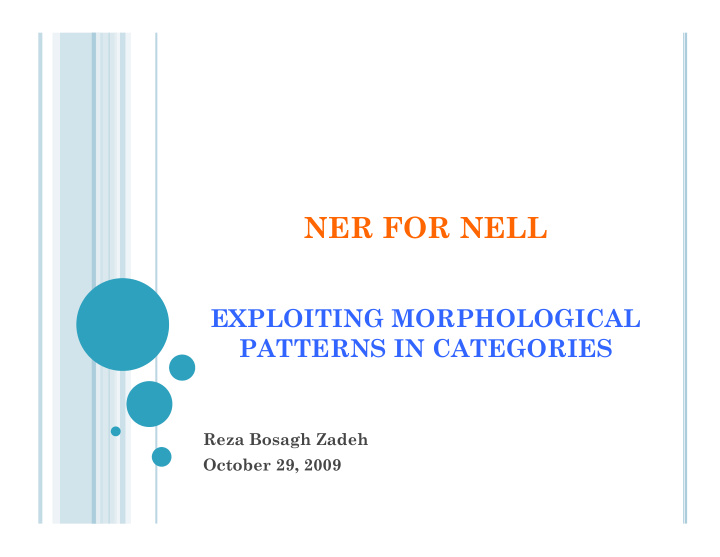



NER FOR NELL EXPLOITING MORPHOLOGICAL PATTERNS IN CATEGORIES Reza Bosagh Zadeh October 29, 2009
OVERVIEW Task Description How to solve outside a NELL system Simple approach evaluated How to tackle in a NELL system: initial experiments
WHAT IS “NAMED ENTITY RECOGNITION”? Extract named-entities from text, label as “Person”, “Organization”, October 14, 2002, 4:00 a.m. PT etc For years, Microsoft Corporation CEO Bill Gates railed against the economic philosophy of Microsoft Corporation open-source software with Orwellian fervor, denouncing its communal licensing as a CEO "cancer" that stifled technological innovation. Bill Gates Today, Microsoft claims to "love" the open- Microsoft source concept, by which software code is made Gates public to encourage improvement and development by outside programmers. Gates Microsoft himself says Microsoft will gladly disclose its Bill Veghte crown jewels--the coveted code behind the Windows operating system--to select customers. Microsoft VP "We can be open source. We love the concept of shared source," said Bill Veghte, a Microsoft Richard Stallman VP. "That's a super-important shift for us in founder terms of code access.“ Free Software Foundation Richard Stallman, founder of the Free Software Foundation, countered saying… Slide: William Cohen, Information Extraction
WHAT PATTERNS? Yarow-sky Min-ski Bosagh-Zadeh Milose-vitch Current RTW system helps us find popular names using context frames. Should be able to find patterns in popular names and use them to discover rarely used names.
MODELS FOR NER Classify Pre-segmented Sliding Window Lexicons (Gazetteers) Candidates Abraham Lincoln was born in Kentucky. Abraham Lincoln was born in Kentucky. Abraham Lincoln was born in Kentucky. member? Classifier Classifier Alabama which class? which class? Alaska … Try alternate Wisconsin window sizes: Wyoming Token Tagging This is often treated as Boundary Models a structured prediction Abraham Lincoln was born in Kentucky. problem…classifying Abraham Lincoln was born in Kentucky. tokens sequentially BEGIN Most likely state sequence? Classifier which class? HMMs, CRFs, …. BEGIN END BEGIN END Slide: William Cohen, Information Extraction
PAPER: MIKHEEV ET. AL. How well can we perform with only a lexicon (list/ gazeteer)? With lists:
NER FOR NELL Don’t have easy access to supervised data: doesn’t fit the never-ending-learner model Context isn’t important anymore! Want to use Morphological patterns abundant in human names and surnames Need to be fast each iteration Initial experiment: focus on suffixes
COMMON SUFFIXES - TRIGRAMS Most common trigram endings of NPs in the list of person names currently obtained from RTW: Not very useful: would have us believe “Rowing” is a person name.
COMMON SUFFIXES - NGRAMS Most common fourgram endings of NPs in the list of person names currently obtained from RTW: Not very useful: would have us believe “Protein” is a person name. Same problem for ngrams of length 3 to 6
PROBLEM: HOW TO FIND DISCRIMINATIVE NGRAMS? Not only identify the most common suffixes in the list of names, but those name suffixes which also appear rarely in all NPs. Two competing requirements Borrow ideas from TF-IDF and define score for ngram i: a i : frequency of ngram i in names list b i : frequency of ngram i in entire NP list
MUCH NICER Take all ngrams and sort by score function Use top 100-scoring ngrams Length freely varying from 3 to 5 Picks up…
MUCH NICER New names, not picked up before List not filtered or altered in any way: all seem to be names Some very familiar-but-rare suffixes, such as -vitch
NEXT STEPS Use prefixes as well as suffixes: McDowell McCartney O'Connor O'Dowel Try other categories Aghani -stan Paki -stan Fin -land Can potentially work for locations: Green -land Eng -land
NEXT STEPS Put this into main pipeline for RTW Insert new names during bootstrapping process Should be interesting to see the interaction between morphologically identified names and names found using contexts Use confidence scores
Thanks!
Recommend
More recommend